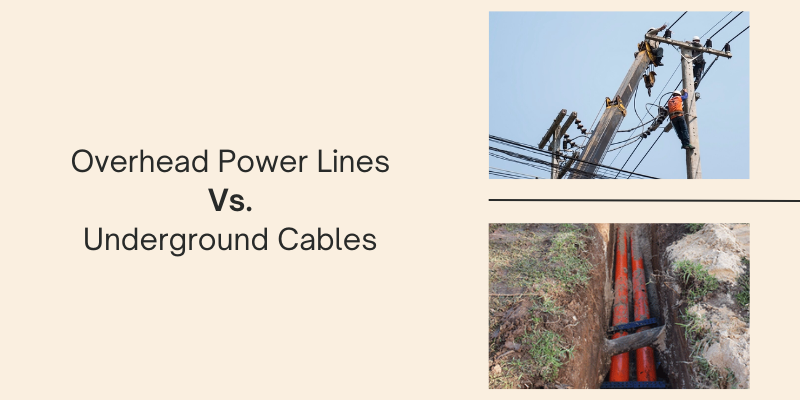Are overhead power lines good, or are underground cables better? This question people often ask after experiencing extreme weather conditions, such as hail damage or wild storms that interrupt electrical services for a significant period. In terms of power delivery, both methods are equally effective. Underground cables tend to be more aesthetically pleasing and present fewer safety hazards. On the other hand, overhead power lines typically boast a marginally greater longevity and are more economical. The cost savings are significant, with overhead options up to 61% less expensive, and a qualified electrician can more readily address their maintenance issues.
Various factors, including geographical location, population density, consumer preferences, and safety considerations, influence the decision between the two systems. Therefore, the choice is more complex than it may appear. Additionally, a basic knowledge of the overall electrical grid is beneficial in understanding this issue.
Understanding the Electrical Grid
The electrical grid covers the whole process of electricity delivery from production to end-use. The process consists of:
- Electricity Production: Power is produced in generating plants. The AEMC (Australian Energy Market Commission) is a valuable resource that locates the plants where we consume our electricity within Sydney.
- Transmission and Distribution: Infrastructure such as substations and transformer boxes facilitate the movement of electricity involving overhead lines or underground cables.
- Consumption: Electricity is used in homes or businesses and managed via the property’s switchboard.
The grid’s structure is crucial when considering overhead lines and underground cables, as it affects how electricity can be accessed, especially in areas with challenging geography that may include lakes and mountains.
The Practicality of Overhead Power Lines
Overhead power lines, the prominent electrical poles lining most streets, are available in timber and galvanised steel varieties. Electricians find them more straightforward to adjust and repair due to the visible nature of any faults. Despite this, they are more vulnerable to environmental factors. Common issues include:
- Tree limbs on lines.
- Vehicle collisions with poles (notably in Sydney).
- Weather-related damage.
- Erosion.
- Wildlife interactions.
When overhead lines age and near the end of their service life, they must be assessed for upgrades. This juncture often prompts consideration of whether to maintain the overhead system or switch to underground solutions.
Addressing Issues with Private Power Poles
When a private power pole is detected faulty, it can lead to the issuance of an electrical defect notice. This notice typically arises when utility companies like Ausgrid, Essential Energy, or Endeavour Energy determine the connection to the leading power network poses a safety risk. Property owners are given a 21 to 30-day window to rectify the issue by engaging a certified Level 2 ASP electrician. Failing to do so may result in the disconnection of the electricity supply. Common problems associated with private power poles that may need attention include:
- Faults with the point of attachment brackets.
- Issues with the consumer mains.
- The necessity for pole replacement, repair, or installation.
- Switchboard upgrades to accommodate 3-phase power.
The Prospects of Underground Powerlines
Underground power is becoming the norm in many urban areas, including Sydney. Their integration into the urban landscape is seamless, offering a visually pleasing solution that significantly reduces exposure to environmental risks, thereby enhancing safety and appeal. These cables stay hidden as they pass under the ground, making them ideal for densely populated regions where space is at a premium, such as cities and residential neighbourhoods. The freed space can then be repurposed for public amenities like walkways and infrastructure, contributing to the locality’s property value.
Nevertheless, there are specific trade-offs to consider. The initial installation costs for underground cables are significant because they require electrical insulation to shield against moisture and corrosion. Additionally, pinpointing issues can be challenging since the cables are not readily accessible. Excavation might be necessary to solve a significant fault; however, this is less likely with new installations.
Evaluating Underground Versus Overhead Power Solutions
From a contemporary standpoint, underground cables are often favoured for their sleek appearance and significant risk mitigation, positioning them as preferable for electrical infrastructure. Yet, they have drawbacks, including higher costs. As technological advancements progress, the trend towards underground cabling is expected to grow. In Sydney, for instance, new developments in populated regions are mandated to implement underground cabling.
Ultimately, the selection between underground and overhead options is personal and influenced by individual needs and specific situational factors.
Contact IZCO Electrical
If you’re unsure about the electrical option you must select, contact IZCO Electrical for assistance; our team is ready to help you. We’re certified Level 2 Electricians, so we can safely handle severe electrical issues. Our experienced electricians can repair, replace, or install overhead and underground electrical systems anywhere in Sydney.





